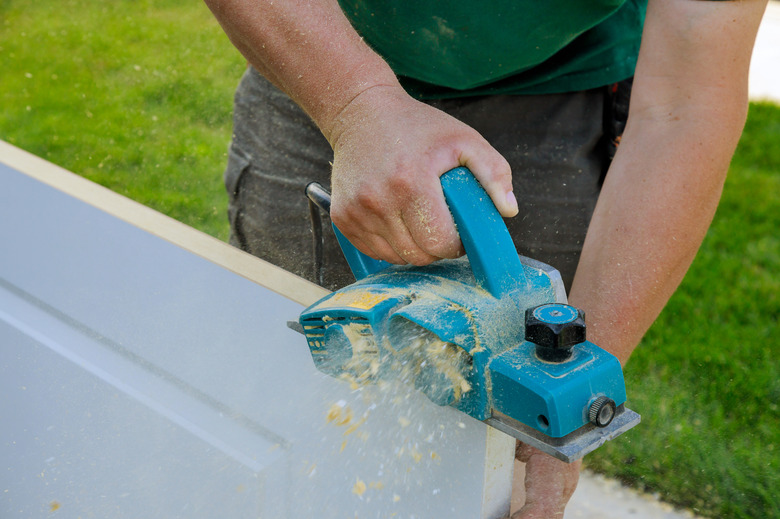How To Shave Down A Door
We may receive a commission on purchases made from links.
A door can stick for more than one reason, and it's fairly simple to get immediate relief by shaving it down. It's a good idea to investigate the cause, though, because it could have something to do with the building's foundation. If you notice cracks in the wall or if other windows or doors in the house are also sticking, the foundation could be settling and throwing door and window frames out of alignment. That would warrant an investigation by a structural expert.
The problem could also be caused by moisture expansion. The best way to prevent this from happening again after you shave down the door is to repaint or refinish the door to protect it from the elements. A third possibility is that the hinges are loose, and in that case, you may not have to shave down the door at all. Tightening the hinge screws, replacing them with longer ones, or shimming the hinges may solve the problem.
What's the Best Tool to Use?
What's the Best Tool to Use?
An electric planer is the best tool to use for shaving down a door, and if you get a lightweight cordless model, you may be able to complete the job without taking the door off its hinges. If you don't have a planer and you don't want to buy one, you may be able to stop the door from sticking by using a power sander. A belt sander works faster than an orbital one, and if the door has several layers of paint, it's the better choice because it will quickly wear through the paint.
You can even complete this job with a hand plane, but if you have to buy one, you're better off getting a cordless planer instead. For one thing, you'll have a hard time finding a hand plane because they are no longer common, and even if you find one, it will probably be more expensive than a cordless model.
Things Needed
-
Piece of paper or cardboard
-
Ruler
-
Paint or clear finish
How to Shave Down a Door
How to Shave Down a Door
You can shave down a door in place, or you can take the door down. Either way, you need to stabilize it to ensure you shave the edge cleanly and don't make a bevel and widen the gap on one side of the door.
1. Mark the Spot That Needs Shaving
Close the door and run a piece of paper or cardboard along the gap on the knob side from the bottom toward the top until it sticks. Mark that spot and then run the cardboard from the top down until it sticks again and mark that spot. The section between the marks is what needs to be shaved.
2. Measure How Much Wood You Need to Remove
Use a ruler to measure about 1/8 inch from the door jamb and make new marks on the door above and below the marks you just made. Set the ruler on the marks and draw a straight line between them. The amount of wood between the line and the edge of the door is what you need to remove.
3. Take Down the Door or Stabilize It
If you decide to take down the door, close it until the knob latches, pull the hinge pins, open the latch and pull, and the door will fall into your hands. Set it on the floor with the edge that needs shaving facing up. Stabilize it by leaning it against a chair or something similarly heavy. If you decide to leave the door hanging, open it all the way and jamb rubber wedges underneath it from both sides so it can't move.
4. Plane or Sand Between the Marks
Use a planer or sander to remove material between the marks you made on the door. If you use a planer, make several light passes rather than a single heavy one. Use a belt sander with a medium-grit sanding belt (100 or 120 grit) to avoid removing too much material at once. Stop planing or sanding when the line you made is no longer visible.
5. Test the Door
Rehang the door or remove the stops from underneath it and close it to make sure it doesn't stick. If it does, repeat the procedure to remove a little more material.
6. Touch Up the Finish
Apply new paint or clear finish to the edge of the door and leave the door ajar overnight to give the material time to dry.
